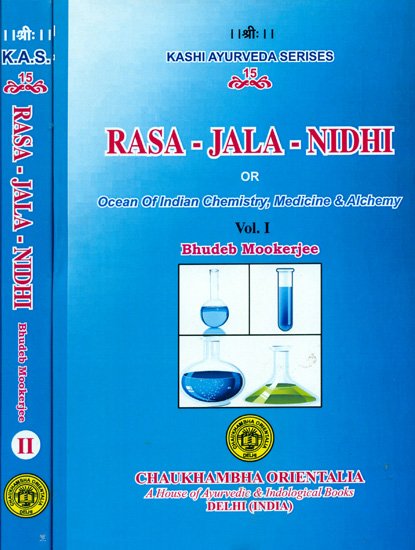Rasa Jala Nidhi, vol 3: Metals, Gems and other substances
by Bhudeb Mookerjee | 1938 | 47,185 words | ISBN-10: 8170305829 | ISBN-13: 9788170305828
This third volume of the Rasa-jala-nidhi deals with purification techniques of the Seven Metals (sapta-dhatu) and various Gems (ratna). It also deals with substances such as Alkalis (kshara), Salts (lavana), Poisions (visha) and Semi-poisions (upavisha) as well as various alcholic liquors. The Rasa-jala-nidhi (“the ocean of Iatrochemistry, or, che...
Part 6 - Process of preparing Sarva-kshara
A middle-aged black mokshaka tree growing in a valley of a mountain is to be cut into pieces, sometime in the two months following the rains, and kept in a heap in a place protected from drafts of air. Some lime stone (or balls of lime-mud dried up, generally known by the name of “ghuting”) is also to be kept inside the heap of wood, which is to be burnt by fire made of sesamus plant. The ashes of the wood are then to be separated from the burnt lime-stone, as well as from the burnt soil upon which the act of burning takes place.
In the same way, ashes will have to be prepared from the following trees (or plants, as the case may be):—kutaja, palasha, asva-karna (a kind of shala), paribhadra, bibhitaki, aragbadha, lodhra, arka, snuhi, apamarga, patali, bisha-karanja, basaka, kadali, chitraka, putika (rama-karpura), kutaja, asphota (bhadra-balli),[1] karabira, saptaparni, agnimantha, gunja, and four kinds of ghosha (including deva-dali).
Two thirds of a drona of the ghanta-patali kshara and one third of a drona of the kshara prepared from kutaja and the other trees, referred to above, are to be dissolved with water or cow’s urine, six dronas in weight, and filtered for 21 times. The solution is next to be subjected to heat till it becomes clear, red, acrid, and sticky, when it will have to be filtered again, rejecting the dregs. The solution, thus filtered, may be used as a liquid kshara, if necessary.
Take one kuraba or 1½ kuraba of this solution, and rub it with 8 palas of all these combined:—burnt lime, burnt sand obtained from the spot where the wood was burnt, oyster shells burnt, and nabhishankha (a kind of conch shell)—each equal in quantity, and previously made red-hot by heating in an iron cauldron. The paste, thus prepared, is to be boiled with two dronas of the liquid kshara, referred to above, turning it, all the while, by an iron ladle in such a way as to make the product neither solid nor liquid. The kshara, thus prepared, is of moderate strength. It would be mild, if prepared in the above way without the mixture of the paste, referred to above. It can be rendered the strongest, if prepared with the addition of four tolas in weight of the fine powder of each of the following, mixed in course of the heating:—danti, dravanti, chitraka, langalaki, leaves of nata-karanja, tala-muli, bira-salt, svarji-kshara, svarna-kshiri, hingu, baeha, and ati-visha.
These ksharas are to be kept in jars with their mouths covered.[2]
Footnotes and references:
[1]:
Bengali, “hapharmali”. Asphota may also mean red arka.
[2]:
For details see, Chapter XI, Sutra-sthana, and XXXXII, uttaratantra, Sushruta.
Conclusion:
 This concludes ‘Process of preparing Sarva-kshara’ included in Bhudeb Mookerjee Rasa Jala Nidhi, vol 3: Initiation, Mercury and Laboratory. The text includes treatments, recipes and remedies and is categorised as Rasa Shastra: an important branch of Ayurveda that specialises in medicinal/ herbal chemistry, alchemy and mineralogy, for the purpose of prolonging and preserving life.
This concludes ‘Process of preparing Sarva-kshara’ included in Bhudeb Mookerjee Rasa Jala Nidhi, vol 3: Initiation, Mercury and Laboratory. The text includes treatments, recipes and remedies and is categorised as Rasa Shastra: an important branch of Ayurveda that specialises in medicinal/ herbal chemistry, alchemy and mineralogy, for the purpose of prolonging and preserving life.
